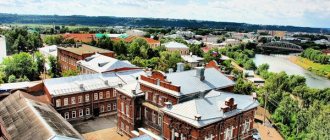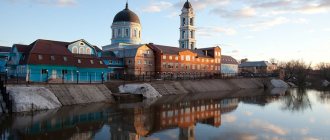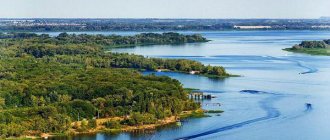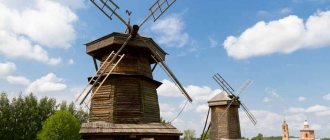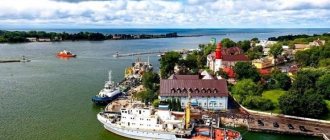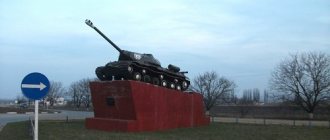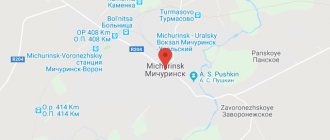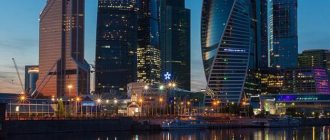Where is Lipetsk?
Lipetsk is the administrative center and capital of the Lipetsk region, which is located on the same latitude as the major European cities of Amsterdam and Berlin.
The city is located in the European part of Russia, the distance to Moscow is about 460 km. Lipetsk is located on the Voronezh River (on both banks) in the forest-steppe zone of the temperate zone, right on the border of the Central Russian Upland. The approximate population of the city is 510 thousand people. The total area of Lipetsk is 330 square kilometers. Nearest large cities: Tula, Moscow, Yelets, Novomoskovsk, Saransk, Nizhny Novgorod, Orel, Kursk, Belgorod, Sumy, Saratov, Voronezh, Volgograd, Kaluga. The city center of Lipetsk is located in the hills near the mouth of the Kamenny Log and in the lowlands of the Lipovka River. The length of the city from west to east is 27 km, from south to north – 22 km. The climate in Lipetsk is temperate continental. The annual precipitation rate is 500 mm, with maximum precipitation occurring in July.
Lipetsk is in the same time zone as Moscow, the offset relative to Coordinated Universal Time (UTC) is +3.
Lipetsk
general information
Lipetsk is a modern and dynamically developing city. It is known in Russia and abroad as a major producer of steel and rolled products, white equipment, juices and mineral water, and as a center for training aces of domestic aviation. Here are concentrated enterprises that, with their successful work, ensure the social stability of the entire region: the flagship of the domestic metallurgy Novolipetsk plant and the oldest metallurgical plant in the industry, producing refrigerators and washing machines. A powerful potential for the construction and construction industry has been created - there are factories for the production of cement, silicate products, reinforced concrete floors, and plastic windows. The food, processing and light industries are widely represented, and the consumer market is saturated with trade enterprises.
Attractions
In Lipetsk there is the only factory in Russia that produces Lipetsk patterns (painting on wood according to the Khokhloma type).
There are many beautiful fountains in the city. In recent years, a color and music fountain has been opened on Peter the Great Square, cascades of fountains on Petrovsky Spusk and on Teatralnaya Square. In addition, pre-existing structures underwent thorough reconstruction.
Temples and monasteries
Ascension Cathedral is a destroyed cathedral in the city of Lipetsk. It was located on Voznesenskaya Square (now Teatralnaya Square).
The cathedral is the first stone church in Lipetsk. It was built in 1751 at the Lipa factories. The construction was carried out in several stages, so the bell tower was built after 1812. In 1850, the cathedral was expanded and it acquired its final form.
The temple was in the form of a two-height quadrangle with side chapels and a low dome. The façade was decorated with Baroque architraves and paired pilasters. There were three limits in the Ascension Cathedral: in the name of the Ascension of the Lord (main), Archangel Michael and St. George the Victorious (alteral).
The Church of St. Eudokia (Evdokievskaya) is an Orthodox church, located in the center of Lipetsk near Heroes Square (address: Gagarin Street, 70). She is one of the few that has survived to this day after Soviet atheism.
St. Nicholas Church is a small temple on Torgovaya Square, 16a, in the Soviet district of the city of Lipetsk.
The building in the Russian style was erected according to the design of the architect I.P. Mashkov in 1890. The church was consecrated in the name of St. Nicholas the Wonderworker. It was adjacent to the Prison Castle (it was demolished after the revolution). The temple had a fairly powerful belfry, and the largest bell weighed 7 tons.
Museums
The House-Museum of G. V. Plekhanov is a memorial museum in Lipetsk. Located at: Plekhanov street, 36.
Lipetsk Regional Museum of Local Lore is the central museum of the Lipetsk region. Located on Lenin Street, 25 (corner with Proletarskaya Street).
The local history museum was founded in 1909. The initiator of the creation and its first director was M. P. Trunov, the founder of library and archival business in Lipetsk.
Theaters
The Lipetsk State Academic Drama Theater named after L.N. Tolstoy successfully tours Russia. It includes many honored and national artists. The main director is S. A. Bobrovsky.
Also in Lipetsk there is the Lipetsk Municipal Theater, which does not yet have its own building (located in the building of the Sokol Palace of Culture), but is considered a promising theater, competing with the regional theater. Artistic director - G. V. Balabaev.
The Lipetsk State Puppet Theater, which is now directed by O.V. Ponomarev, operates for young spectators.
Parks
Bykhanov Garden is a park in the Right Bank district of the city of Lipetsk. The official name is the Bykhanov Garden park. It is located between Gagarin, Balmochny, Telman streets and the Evdokievsky cemetery. Area is 13.8 hectares. The tree species are dominated by spruce, birch, and chestnut. Ornamental shrubs, dwarf rowan trees, apple and pear trees also grow here.
Victory Park is a park in the Oktyabrsky district of the city of Lipetsk. It is located between Avenue 60 Let of the USSR, Poligraficheskaya Street, the Kamenny Log tract and residential buildings along Smurgis and Stakhanov streets. Area - 35 hectares. There are more than 40 species of trees and shrubs in the park. The composition of tree species is dominated by pine, birch, and maple.
Story
A fortified Slavic settlement on the site of the modern city existed even before the start of the Mongol-Tatar invasion. It was located on a steep hill, protected from the north, south and west by inaccessible slopes. On the flatter eastern side, an earthen defensive hill was erected, the remains of which have survived to this day. In the center of the settlement there was a princely house, and artisans lived around it. Lipetsk was first mentioned in chronicles in 1283-1284, during the period of battles between the Russians and the Mongol-Tatar conquerors. In 1284 the city was completely destroyed, and over the next few centuries there is no mention of it.
The village of Malye Studenki Lipskie, located on the site of the modern city, was first mentioned in chronicles in the first half of the 17th century.
The year 1703 is considered to be the year of the founding of Lipetsk (City Day is celebrated on the 3rd Sunday of July). It was then, on the orders of Peter I, on the Lipovka River, at its confluence with the Voronezh River, that the construction of iron factories began for the needs of the Russian fleet and army, which provided great support in supplies during the Northern War. By this time, the factories began to be considered large, and occupied second place in Russia in the production of cast iron.
The village, which expanded after the construction of factories, was renamed in 1709 into the settlement Lipskie Zavody (Lipskie Iron Works). On September 16, 1779, by decree of Catherine II, the Lipskiye Zavody settlement officially received the status of a district town of the Tambov governorship (since 1796 - Tambov province) with the name Lipetsk. The city included two settlements - Dikinskaya and Lipetskaya, together with factories, as well as the villages - Korovino and Dikinskaya. At that time, about 6 thousand people lived here.
On August 16, 1781, Lipetsk received its coat of arms. Under the Tambov provincial coat of arms (a beehive and three golden bees) there is a spreading linden tree, as a symbol of antiquity and prosperity, like the family tree of a revived city.
After the opening of new iron smelting plants in the south of Russia with a new, more advanced technology for smelting iron and steel using coke in 1795, the Lipsky plants were liquidated, and the bulk of the equipment and workers were transferred to the Lugansk plant. After the factories closed, the city's development slowed down.
In 1806, a large fire occurred in the chaotically built-up wooden Lipetsk, after which the city began to be built according to the General Plan, with straight, wide streets and buildings made of stone and brick. Resort buildings, a hotel, and an entertainment hall were built. Noble and merchant mansions appeared on Dvoryanskaya Street (now Lenin Street).
The revival of the city began at the end of the 19th and beginning of the 20th centuries, when, in connection with the expansion of railway construction, Russian and foreign entrepreneurs decided to reuse the ore deposits near Lipetsk. The revitalization of the city was also facilitated by the activities of the resort, opened at the beginning of the 19th century.
In 1902, with the participation of Belgian capital, the construction of two blast furnaces was completed, marking the beginning of the metallurgical industry, which produced the first cast iron on July 15, 1902.
In 1931, another giant was founded - the Novolipetsk Metallurgical Plant (NLMZ, now the Novolipetsk Metallurgical Plant - NLMK), which began operations on November 7, 1934. The construction of this enterprise became a turning point in the biography of Lipetsk. It was NLMK that brought Lipetsk world fame as an industrial center. Since the 1930s, Lipetsk has transformed from a small provincial town surrounded by greenery into a large industrial center of the Black Earth Region.
During the Great Patriotic War, in 1943, the Lipetsk Tractor Plant was built in record time.
On January 6, 1954, the Lipetsk region was created, and the city received the status of a regional center.
Transport
Lipetsk has a developed transport infrastructure; it is connected with other regions by rail, air and road transport. Lipetsk Airport is located 10 km from the city, from which there are daily flights to Moscow and St. Petersburg, there are also a number of flights to other Russian cities, and there is also an air taxi service. The roads have access to the federal highways M4 Don and M6 Caspian, as well as the Orel - Lipetsk - Tambov highway.
City public transport is represented by buses, trolleybuses and trams. Every day Lipetsk residents are transported by 118 trolleybuses and 70 tram cars, however, at present the tram has practically left the central part of Lipetsk, but is actively used in the areas of urban new buildings and in the Left Bank. Tram traffic in Lipetsk celebrated its 60th anniversary in November 2007. The issue of introducing a high-speed tram is currently under development.
Lipetsk Airport
The city of Lipetsk has an international airport, which has the status of federal significance. Airport type: civil. The airfield is located 15 km northwest of the center of Lipetsk. Nearby is the village of Kuzminskie Otverzhki. The airport operates 24 hours a day. To get to the airfield building you need to use public transport or taxi services. Passengers are also provided with the possibility of an individual transfer. The airport building was built in 1966.
The most popular destinations of regular and charter flights: Kaliningrad, Moscow, St. Petersburg, Kazan, Yekaterinburg, Gelendzhik, Adler, Voronezh, Simferopol, Anapa, Murmansk, Minsk, Rostov-on-Don, Sochi, Sochi. Lipetsk airport serves flights of major Russian airlines: RusLine, S7 Airlines. The annual passenger traffic is 57 thousand people.
The airport runway has an asphalt concrete surface. The airfield received international status after reconstruction in 2015. Then the first international flight Lipetsk-Milan was made from the airfield.
Statistics on population and demographics
If we consider the cities of the Black Earth Region, then Lipetsk ranks first among them in terms of population growth and second in terms of its size. In 2014, statistics were collected showing that the city had a population of more than 510,000 people. Half a century earlier in Lipetsk the number was 123 thousand.
From 2022 to 2022, the local population decreased by 9 thousand, but this figure is so small that it does not change the overall picture of the demographic situation. Most likely, the changes occurred due to the fact that part of the adult population left to work in the capital, others did not want to take the census, and others were simply not registered.
Population dynamics of Lipetsk
Moscow is close, earnings in the capital are many times higher, so many people go to improve their financial situation or earn money for an apartment. But, having saved the required amount, Lipetsk residents most often do not move to the capital, but return to their hometown: it is quieter here, life is cheaper, and apartments are more affordable.
Train Station
The Lipetsk railway station of the Michurinsky region of the South-Eastern Railway is located at st. Gagarina, 106. The two-story station building was built in the 1960s. In 2003, the railway station was completely reconstructed: the windows were replaced, the facades were painted, and the clock mechanisms on the tower were restored. Passengers can get to the railway station building by public transport. There is free parking for cars on the station premises.
The most popular long-distance train destinations: Moscow, Baku, Kislovodsk, St. Petersburg, Vladikavkaz, St. Petersburg, Adler, Voronezh, Minsk, Mineralnye Vody, Anapa, Saratov, Volgograd. New destinations are added in the summer season: Sukhum, Anapa, Novorossiysk, Yeysk. Lipetsk railway station also serves commuter trains.
In the station building, passengers have access to a café, storage lockers, a medical center and a spacious waiting room.
What do migrants need to know?
Lipetsk and the region have a clear advantage over other areas. The region is located in the most developed part of the country. The region produces various ferrous metallurgy products (rolled products, steel, cast iron), household appliances (refrigerators, tractors), and food products. From the total production of the country in the region they produce:
- Household freezers and refrigerators - 40%.
- Granulated sugar - 8%.
- Tractor cultivators - 22%.
- Canned fruits and vegetables - 25.2%.
- Tractors - 7.1%.
- Cast iron - 19.2%.
- Finished products - 15%.
- Mineral waters - 7%.
Thanks to highly developed agriculture, the metallurgical industry and other areas of production, you can quickly find work with a good salary for specialists in various professions.
Employment structure by industry sector in the Lipetsk region
Bus stations of Lipetsk
The bus station in Lipetsk is located at Pobedy Avenue, 89, not far from the Ring Square. Opposite the main bus station building there is a plumbing store called Santekhtsentr. The station operates 24 hours a day, without weekends or long technical breaks. You can get to the bus station building by public transport or taxi.
Buses depart on more than 80 routes every day: Ivovo, Chistaya Dubrava, Casino, Novoe Dubovoe, Michurinsk, Verkhniy Telelyuy, Penza, Mokroye, Stanovoe, Lebedyan, Borovoe, Usman, Fomina-Negachevka, Krasnoe, Yelets, Dolgorukovo.
Automobile highways
Two federal highways pass through Lipetsk:
- P119 is a federal highway with a total length of 395 km. The highway connects 2 cities - Tambov and Orel. The route passes through the following cities: Lipetsk, Livny, Yelets. Road surface: asphalt.
- A133 is a highway that has the status of federal significance. The length of the route is 45 km. The road starts from the M4 Don highway and runs to Lipetsk. Road surface: asphalt.
What is Lipetsk famous for?
Lipetsk is known for the fact that the city is considered one of the largest centers of steel and rolled metal production. The city is also home to a popular pilot training center. One of the main attractions of Lipetsk is Peter Square. There are singing fountains, a monument to Peter I, parks and the Green Theater here. In the Soviet district of the city there is Cathedral Square, where the Nativity Cathedral was built in the mid-19th century.
On Plekhanov Square there is a monument to the founders of Lipetsk. The monument was erected in 2008. On Victory Square, city tourists can see the “Victory Stele” monument, whose height is 38 m.
The opinion of Lipetsk residents themselves about their city
Reviews on the Internet can be found very contradictory: some claim that it is the best place to live (the climate is excellent, you can find a good job, and you can afford to buy an apartment). Visitors say the opposite: there are problems with work, housing is expensive, people are not very friendly (and this is putting it mildly).
And yet people leave their homes and come here for permanent residence.
Lipetsk residents themselves cite the following characteristics of the city as advantages:
- Wide and spacious avenues and streets.
- The road surface is good, but after winter every year the roads need repairs.
- Thanks to its good modern architecture, the city looks well-maintained.
- There are many fountains and flower beds everywhere, which are constantly looked after by special services.
- There are many small businesses offering a variety of services, from shoe repair to organizing various events.
The Lipetsk region ranks 8th in the ranking of quality of life in the regions of the Russian Federation
The disadvantages of both local residents and visitors include the following facts:
- The city was built chaotically, widely scattered throughout the territory.
- Difficult terrain. A wild ravine runs through the entire city, making development of the territory very difficult. But this fact causes a double opinion; many people like the unevenness of the relief, which gives it originality.
- Presence of large industrial enterprises. But thanks to this, Lipetsk became the most important industrial center, taking second place after the capital. In addition, large factories provide attractive infrastructure and ample opportunities for economic growth. Thanks to large enterprises, the standard of living of city residents has also increased significantly.
- Lack of ancient sights.
Note : the city began to be built up in the middle of the last century, so there really are no old buildings or other attractions here. But there is something else - nature. Two nature reserves have been opened in the Lipetsk region. One of them, Galichya Gora, was listed in the Guinness Book of Records as the smallest in the world.
There is another important natural attraction here - open springs with healing mud and sodium chloride-sulfate water. The springs were discovered 200 years ago, and on their basis a resort was opened at that time, which is still in operation today.
Those who find themselves in the city usually make their first trip to these life-giving waters.
Watch the video: Sights of Lipetsk.



